Read this article in Spanish
Samarkand, Uzbekistan, November , 2012
Feature article about the traditional food from Uzbekistan, Plov and the unifying culture that surrounds it.
“Roberto, don’t eat the meat first, my friends are starting to look at you in a very weird way”, Jamshid whispered to me like an old woman would lecture her grandchild at church.
I was doing it all wrong.
It was the middle of September and Annika and I were invited to try out Plov, Uzbekistan’s national dish. We were unsuspectingly invited by the group of souvenir merchants just outside their shops in the patio. All the shops, decorated with colorful artifact, offered Uzbek handcrafts to tourists. We were in one of the group of shops in the city of Samarkand The second largest Uzbek city was a declared UNESCO World Heritage Site and home of the imposing Registan (an ensemble of buildings that include three Madrasahs and a Mosque) right in the heart of the town. Here tourism is the main business and the merchants try to do their best effort to sell their pieces.
It did not take much to be invited. While Annika was wondering around the shops looking for something nice to send home as a souvenir, I saw a man cooking what seemed to be a big pile of rice with a lot of fat inside. After realizing that he was cooking Plov I asked him, “Is there a celebration going on today?”. Then another man who was sitting next to the hefty wok answered, “Not really but in 10 minutes it will be ready and we want you to try it out”. Even though Plov is regarded as a festivity dish, it can also be eaten as an excuse to share quality time and feed a numerous amount of people.
And so Annika and I became part of the group that was to satisfy their hunger with Plov. The man who had answered my question was Jamshid, a slim dark haired young man in his mid 20’s.
He escorted me to the men´s table while Annika was respectively invited to join the women´s area. She was immediately welcomed with a glass of coke and a spoon.
It is a custom that when eating Plov men and women eat in separate tables. The reason may be rather disturbing for western culture, but it has to do with drawing the line of who is who in the gender distinction. I found it very odd but in a way I felt I had to sink in to their traditions and simply enjoy being in a table among only men. That idea strengthened when they offered me vodka. Before I could answer they had already poured vodka into my tea cup to disguise publicly its content.
The food was ready, and men and women drew nearer to the Plov. So the serving parade began. Plov is cooked in a special way, and so it is served with the same honor and respect. Serving a plate of Plov to the large dish called Lagan has its own set of rules. The aim is to present an appealing decorated plate that everybody can have access to.
Plov consists mainly of lamb, onions, carrots and rice. What may vary is the inclusion of raisins, barberries, chickpeas, or assorted fruits. The magic of Plov comes in its particular way to cook it. It is not easy and this is the main reason why men take pride in their ability to cook the most delicious Plov. Apparently not everyone can do it, and the man that develops his own technique and taste is highly regarded among the group. On a curious note, when Plov is cooked for an outside event it is done by men, but when it is eaten inside the house, the woman is in charge of such task.
In order to understand the complexity of both the cooking and the serving here are their steps.
First the meat is sunk in several liters of lamb fat at the bottom of the pan. Then a layer of onion and carrot covers the meat to be later followed by garlic, raisins and the fruit of your choosing. Finally the rice covers up all the layers to confine the heat, the aromas and the tastes of all the ingredients. The key is to know exactly how much time it should stay in the fire and of course keep the flame low but consistent.
Now when the Plov is ready serving time begins. Following the same logic of layers of taste, the plates are served in big amounts in the reverse steps. First the rice, then the carrots and onions, then the fruits, the garlic and finally the meat. Again a key factor is to serve equal proportions in every plate and avoid mixing the ingredients while you pile up the layers. In the end the plate looks so tempting you cannot wait to try it out.
After a couple of shots of Vodka everybody sat down on the table and started to eat. Many ate with their hands as is accustomed. I used a fork because eating rice with your hand is much more complicated that it sounds. Betrayed by my lust for food, I went directly for a chunk of meat on top of the dish. The meat practically melted in my mouth.
That was when Jamshid called my attention.
Here is what I learned. Plov is intended to fill your hunger for the entire day. That is the reason why it is so heavy to the stomach. The layers of food are also aimed to follow a certain order when you eat the dish. Traditionally you should start with the rice and work your way up to the meat. When you get to the meat your stomach is already full from eating the other layers. The meat is like the “best for last” kind of thing. This is also a good way to distribute evenly the amount of meat in a large group. Another rule is that you cannot grab Plov from other sides of the dish that are not faced to you. Normally one dish is served for at least 4 people. So you practically leave it to you luck whether or not you get the big chunk of meat or the small one. In the end everybody has to feel satisfied from both their taste and their hunger.
At the end of the meal, with his stomach full Jamshid said “Here in Uzbekistan we do not care about money, we care more about sharing, about eating. So there is no need to offer us money for this”. He closed by saying “Welcome to our country”.
Astonishing what a simple tradition can teach us about the soul of a country. Here in Samarkand I was reminded on why food is so sacred, it definitely is an agent of fellowship. I will keep that in mind on my next BBQ.

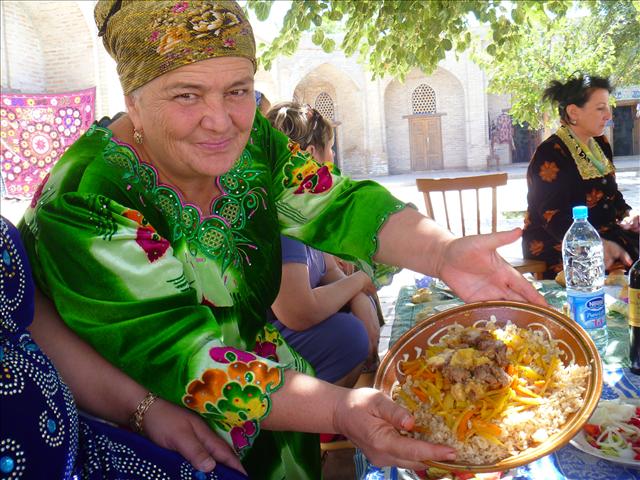
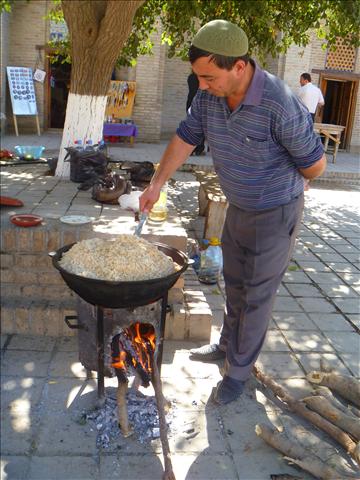
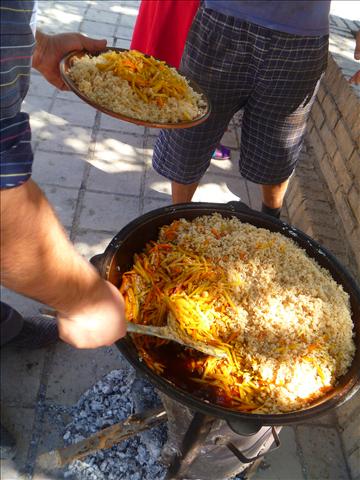
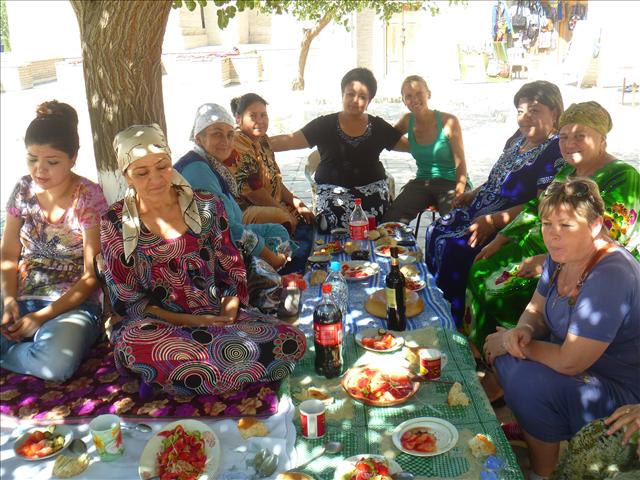
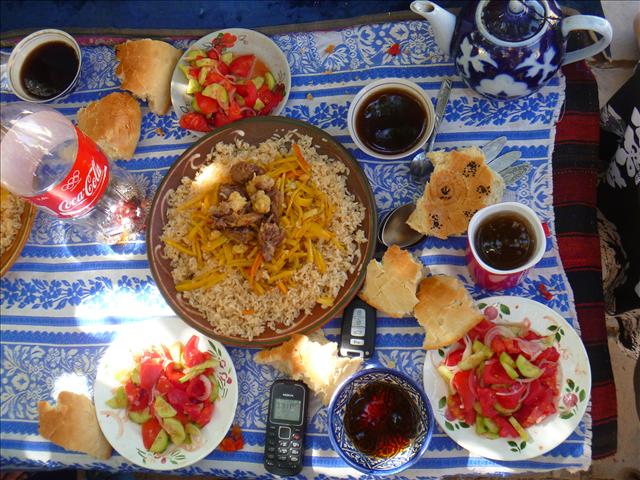
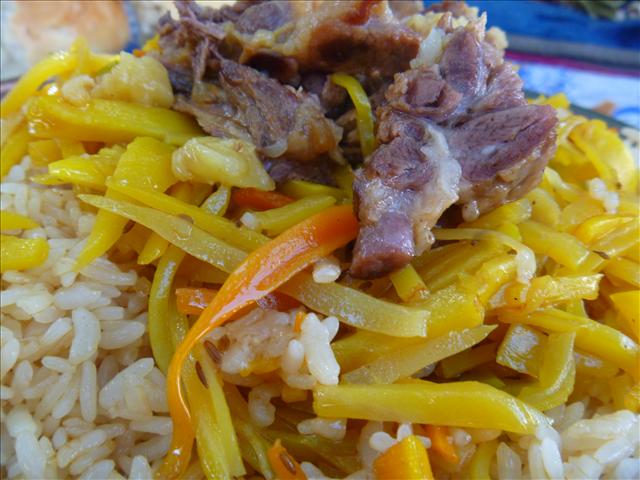

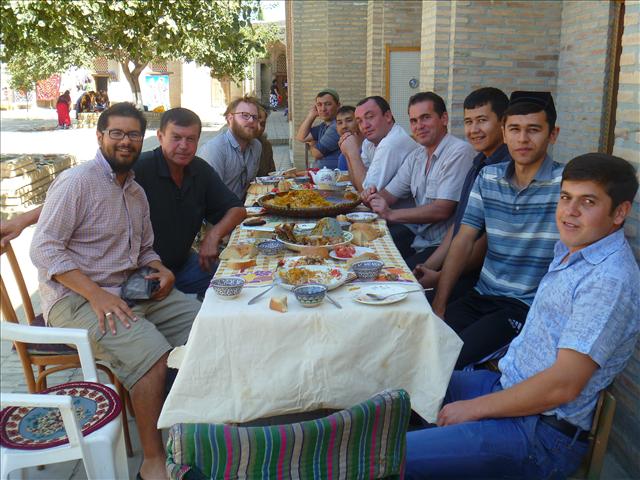





Pingback: Did you know this about UzbekistanTasting Travels
Pingback: Plov : alimento fraternal | Tasting Travels
Pingback: Rice: A True Taste of Asia - Tasting Travels | Tasting the cultures of the world by bike